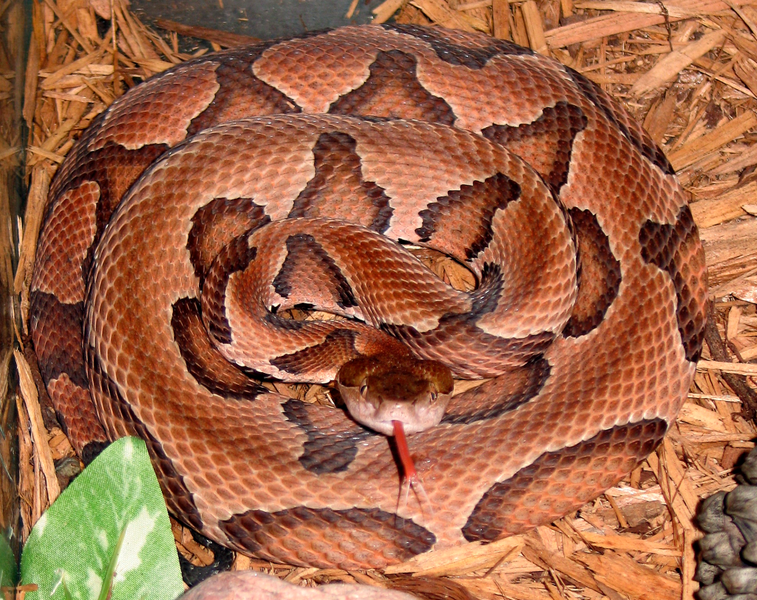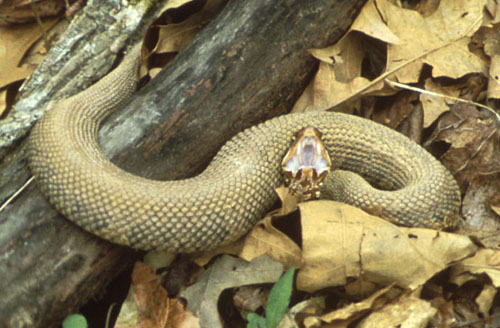Reptiles 103 Chapter 2
Our Very Own Vipers
Although the vast majority of the snakes you’re likely to encounter around the pond are both enormously beneficial and completely harmless, the snakes of the genus Agkistrodon cause very real problems for pond owners in many southeastern states. These are the closely related Copperheads, Agkistrodon contortrix, and the Cottonmouths, Agkistrodon piscivorus, literally “the hooked-tooth fish-eater”, the world’s only semiaquatic viper.

Copperheads, Agkistrodon contortrix
Cottonmouths range from Virginia across to Oklahoma and down to the Gulf of Mexico. Strong swimmers, these snakes are rarely found far from the aquatic environments they prefer, even colonizing barrier islands offshore, although they prefer freshwater swamps to brackish or salt water. Up to 6 feet long and with thick, strong bodies, these large snakes vary greatly in color and pattern, but are easily recognized by their characteristic display of the startling white interior of their mouth when threatened. Luckily, they are far less aggressive than was once believed, preferring to flee or threaten rather than bite; there have been only 3 confirmed fatalities since 1934.
Copperheads, also known as Moccasins from their Algonquin name Mokasen, are considerably less restrained. There are more bites by Copperheads than any other venomous snake in the US, mainly because their threat display is a strike – that is, they will almost immediately strike if they cannot escape, rather than threaten open-mouthed like the Cottonmouth. However, Copperheads are by far the least dangerous, for three reasons: they are relatively small, typically only 30” in length; their venom is the weakest of all native venomous species and they rarely waste venom unless absolutely necessary, often injecting little to no venom with a threat strike. These snakes are common enough that there are pondbuilders in the Houston area who will not build a dry-stacked natural stone waterfall because it will almost certainly, and almost immediately, attract Copperheads.

Cottonmouth
So what do you do if you think you have a venomous snake in your back yard? Well, first off, DON’T MESS WITH IT. The only way you’re going to get bit by any snake is if you go harassing it, it’s certainly not going to go out of its way to mess with you. The most effective methods to discourage them from visiting is to eliminate or drastically reduce the habitat they prefer. Don’t build rock walls with perfect sunning platforms and shady hiding spots that will attract them. Cut back the amount of plant material in and around your pond. Snakes absolutely do not like wide open spaces and prefer to keep to thick vegetation and shadows. Keep your landscaping well-manicured and snakes will find another place to hang out. Herons, owls, hawks, opossum and fox keep snakes under control of the water, while snapping turtles will take them while swimming.
Although the vast majority of the snakes you’re likely to encounter around the pond are both enormously beneficial and completely harmless, the snakes of the genus Agkistrodon cause very real problems for pond owners in many southeastern states. These are the closely related Copperheads, Agkistrodon contortrix, and the Cottonmouths, Agkistrodon piscivorus, literally “the hooked-tooth fish-eater”, the world’s only semiaquatic viper.

Copperheads, Agkistrodon contortrix
Cottonmouths range from Virginia across to Oklahoma and down to the Gulf of Mexico. Strong swimmers, these snakes are rarely found far from the aquatic environments they prefer, even colonizing barrier islands offshore, although they prefer freshwater swamps to brackish or salt water. Up to 6 feet long and with thick, strong bodies, these large snakes vary greatly in color and pattern, but are easily recognized by their characteristic display of the startling white interior of their mouth when threatened. Luckily, they are far less aggressive than was once believed, preferring to flee or threaten rather than bite; there have been only 3 confirmed fatalities since 1934.
Copperheads, also known as Moccasins from their Algonquin name Mokasen, are considerably less restrained. There are more bites by Copperheads than any other venomous snake in the US, mainly because their threat display is a strike – that is, they will almost immediately strike if they cannot escape, rather than threaten open-mouthed like the Cottonmouth. However, Copperheads are by far the least dangerous, for three reasons: they are relatively small, typically only 30” in length; their venom is the weakest of all native venomous species and they rarely waste venom unless absolutely necessary, often injecting little to no venom with a threat strike. These snakes are common enough that there are pondbuilders in the Houston area who will not build a dry-stacked natural stone waterfall because it will almost certainly, and almost immediately, attract Copperheads.

Cottonmouth
So what do you do if you think you have a venomous snake in your back yard? Well, first off, DON’T MESS WITH IT. The only way you’re going to get bit by any snake is if you go harassing it, it’s certainly not going to go out of its way to mess with you. The most effective methods to discourage them from visiting is to eliminate or drastically reduce the habitat they prefer. Don’t build rock walls with perfect sunning platforms and shady hiding spots that will attract them. Cut back the amount of plant material in and around your pond. Snakes absolutely do not like wide open spaces and prefer to keep to thick vegetation and shadows. Keep your landscaping well-manicured and snakes will find another place to hang out. Herons, owls, hawks, opossum and fox keep snakes under control of the water, while snapping turtles will take them while swimming.




